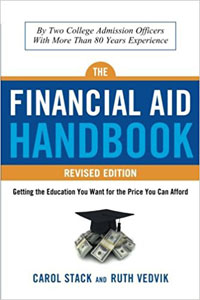 With the availability of more free information on the internet than we know what to do with, the suggestion of reading a book to understand a topic may seem, well, old-fashion. But it’s precisely because of the information overload spawned by the internet that books can be a great investment. A good book will present you with the information you need to know in a meaningful way without any distractions. That has value. And for those looking for such value, I want to recommend The Financial Aid Handbook by Carol Stack and Ruth Vedvik.
With the availability of more free information on the internet than we know what to do with, the suggestion of reading a book to understand a topic may seem, well, old-fashion. But it’s precisely because of the information overload spawned by the internet that books can be a great investment. A good book will present you with the information you need to know in a meaningful way without any distractions. That has value. And for those looking for such value, I want to recommend The Financial Aid Handbook by Carol Stack and Ruth Vedvik.
If you only read one book to understand the intersection of finding and paying for a college, this is it. Carol Stack and Ruth Vedvik have taken their experience as college admission directors and created an essential guide that will take families through a cost based college search. And best of all, it’s written for students.



 Anyone who has been paying attention to college costs and financial aid has probably heard that there really isn’t one set sticker price for college. It’s a lot like airline tickets. People sitting next to each other on a flight probably paid very different amounts for their tickets depending on when they bought them. Like airline tickets, very few families actually pay the sticker price for college.
Anyone who has been paying attention to college costs and financial aid has probably heard that there really isn’t one set sticker price for college. It’s a lot like airline tickets. People sitting next to each other on a flight probably paid very different amounts for their tickets depending on when they bought them. Like airline tickets, very few families actually pay the sticker price for college.
 When looking for a college, it’s a good idea to keep geography in mind. Apparently most families do but not in ways that will improve financial aid or enhance the student’s college education. According to
When looking for a college, it’s a good idea to keep geography in mind. Apparently most families do but not in ways that will improve financial aid or enhance the student’s college education. According to 
 The following is a guest post by
The following is a guest post by  Think because you’re a miserable test taker, you don’t have a chance at merit aid? Maybe not. If you’re willing to step away from the limelight of
Think because you’re a miserable test taker, you don’t have a chance at merit aid? Maybe not. If you’re willing to step away from the limelight of 
 Most parents know that they will need financial aid to send their kids to college. But they don’t always understand financial aid actually comes from a variety of sources and can vary depending on the college. Do you know the answers to the following financial aid questions?
Most parents know that they will need financial aid to send their kids to college. But they don’t always understand financial aid actually comes from a variety of sources and can vary depending on the college. Do you know the answers to the following financial aid questions?


 Anyone who spends time on this blog should realize that very few people pay the actual published price for college. This makes it difficult to judge the significance of the rising prices of college tuition. A lot of schools, especially public institutions, justify increasing tuition by pointing out that a certain percentage of the increase will go to financial aid.
Anyone who spends time on this blog should realize that very few people pay the actual published price for college. This makes it difficult to judge the significance of the rising prices of college tuition. A lot of schools, especially public institutions, justify increasing tuition by pointing out that a certain percentage of the increase will go to financial aid.
 As I work with college data, I learn about different variables and add them to my data sets. I also occasionally create a variable to more accurately capture a concept or value that I think is important when trying to figure out how much college will cost. This is why you’ll see multiple posts on some variation of a list of colleges with the best financial aid. And because of the variation, you’ll always find some colleges on one list and not another. Well, I’m adding another list of colleges to consider for
As I work with college data, I learn about different variables and add them to my data sets. I also occasionally create a variable to more accurately capture a concept or value that I think is important when trying to figure out how much college will cost. This is why you’ll see multiple posts on some variation of a list of colleges with the best financial aid. And because of the variation, you’ll always find some colleges on one list and not another. Well, I’m adding another list of colleges to consider for